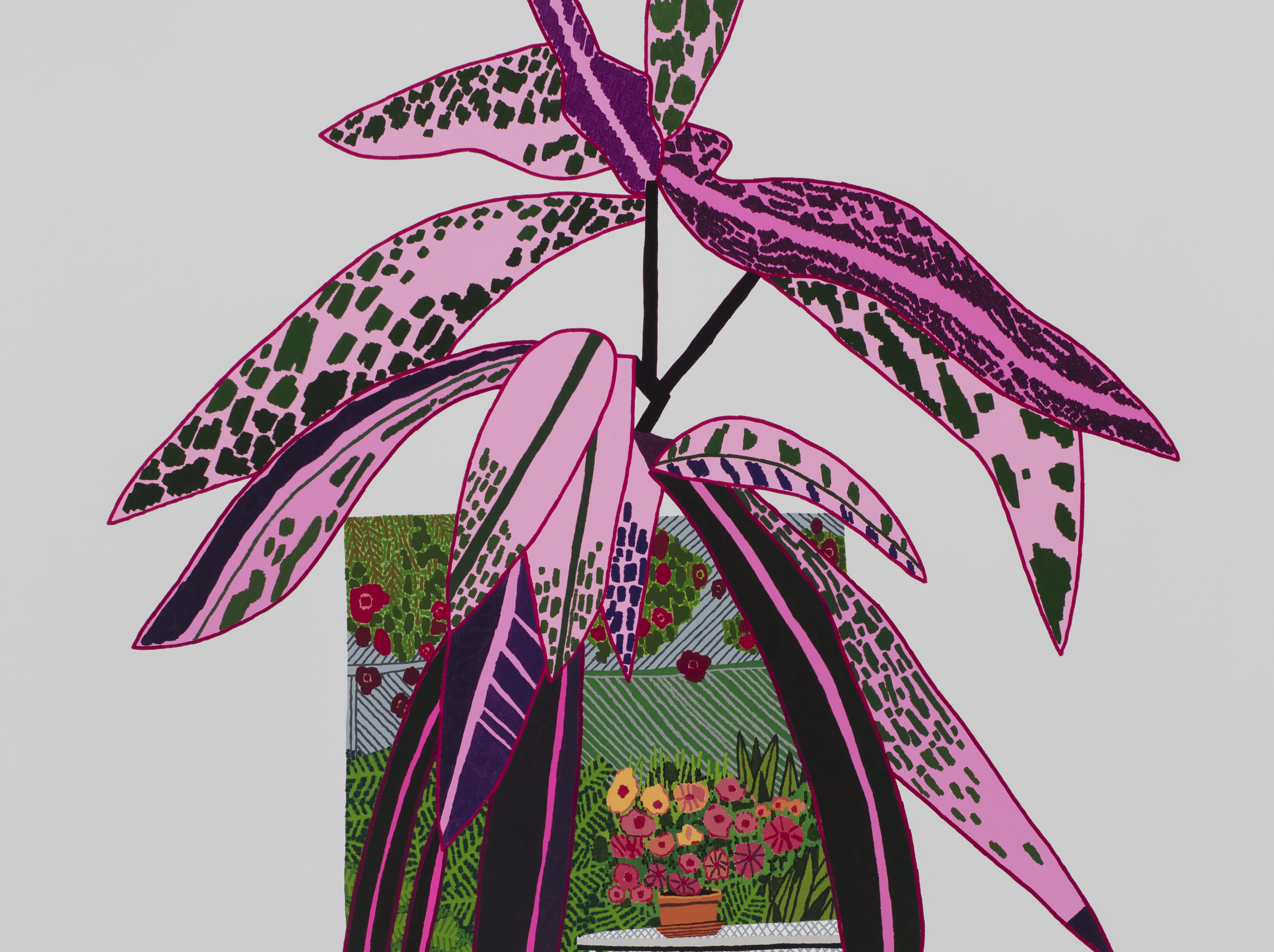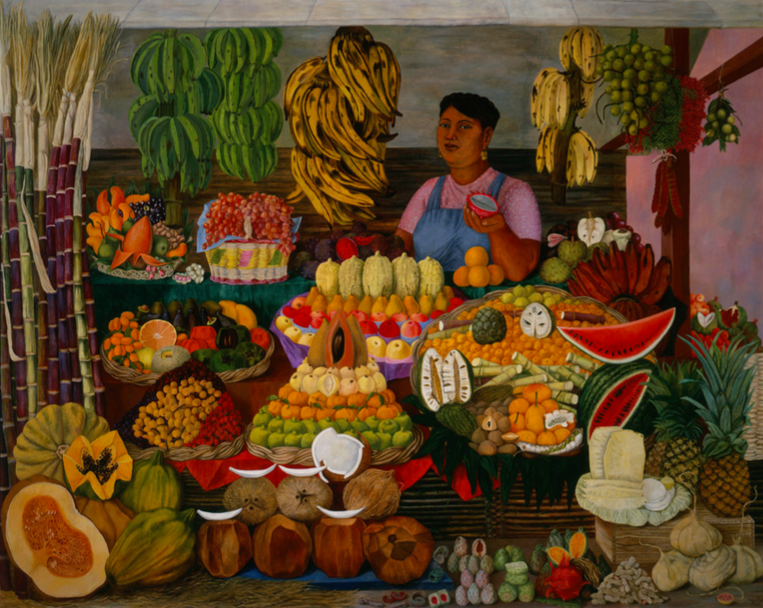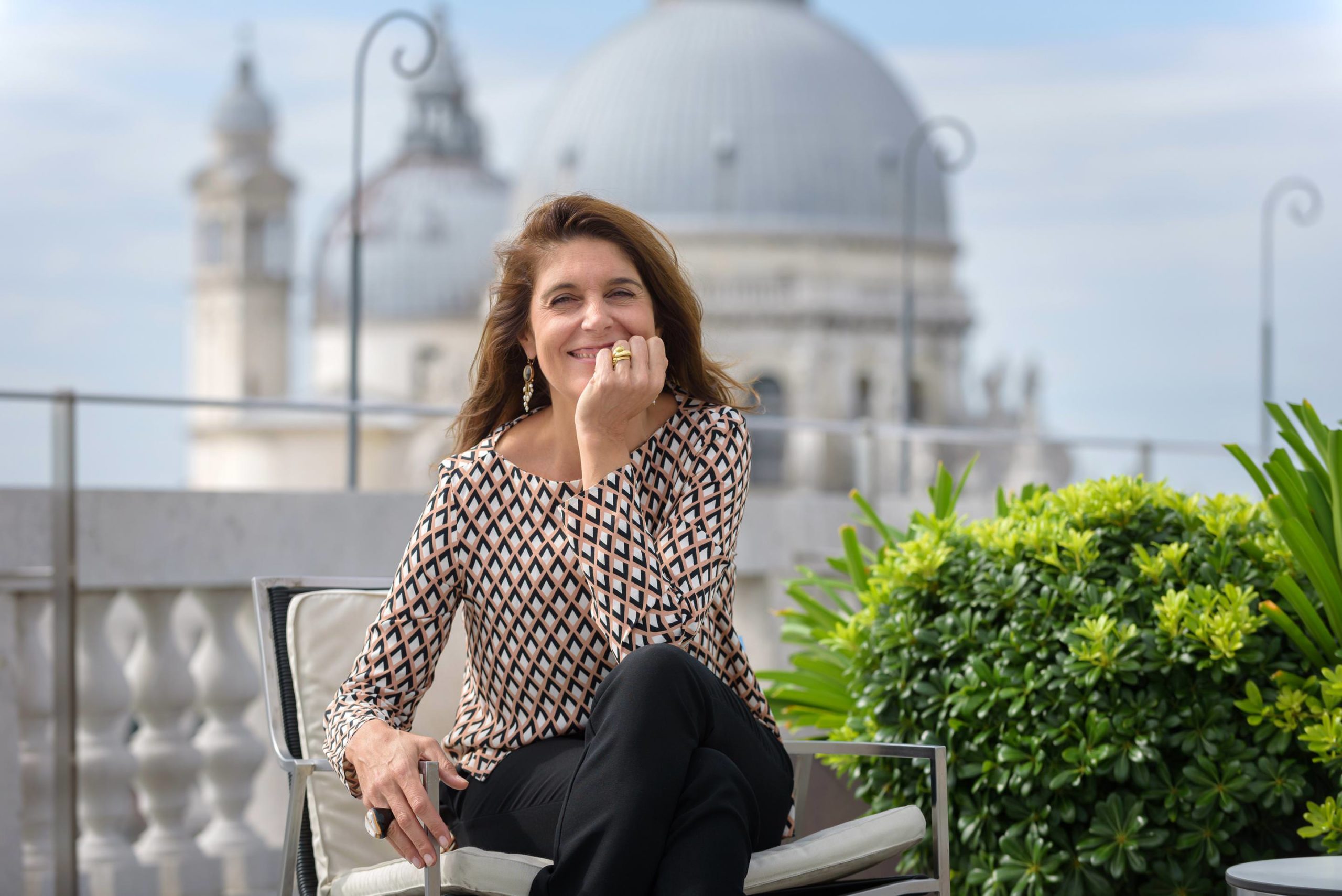It can often be a challenge to try and pinpoint what drives an artist and why they make the things they bring into the world, or what greater narrative these elements might connect to. This is not the case for the French-Swiss artist Julian Charrière, whose vision and mission as an artist are so clearly articulated through his actions and multidimensional, aesthetically mesmerizing body of photographs, films, sculptures, and installations.
Working across a wide array of mediums, and known for a rigorous conceptual, research-based practice, Charrière has become a significant figure throughout the art world and beyond for an artistic practice that is deeply influenced by scientific fields—namely, geology, biology, physics, and archaeology. He has also been the subject of solo museum exhibitions at some of the most prominent institutions around the world, including the San Francisco Museum of Modern Art, the Dallas Museum of Art, and MAMbo – Museo d’Arte Moderna di Bologna, and has participated in significant biennials, including the Biennale di Venezia, the Antarctic Biennale, the Taipei Biennial, and the Biennale de Lyon.
Born in Switzerland and based in Berlin, Charrière has traveled around the globe for his projects, to sites of treacherous terrains, both natural and human-made: volcanoes, ice fields, oil palm plantations, and undersea and radioactive sites. Collaboration is another key ingredient to his process: Often teaming up with scientists, engineers, art historians, composers, and philosophers, Charrière understands that his role as an artist is only enhanced by local experts who can help navigate the interventions he embarks on.
There is no doubt his work is immensely layered, touching on geopolitical, environmental, and economic issues. However, Charrière’s prowess as a maker is guided by an unwavering commitment to aesthetic excellence; the quality and sensitivity imbued in every photograph, sculpture, or film still is miraculously consistent and exceptionally crafted.
In an interview with Whitewall, Charrière discussed the monumental significance of 2024 and the many important shows and projects he has opened, highlights from his recent shows, the work he has done with “Calls for Action,” and what is coming next.
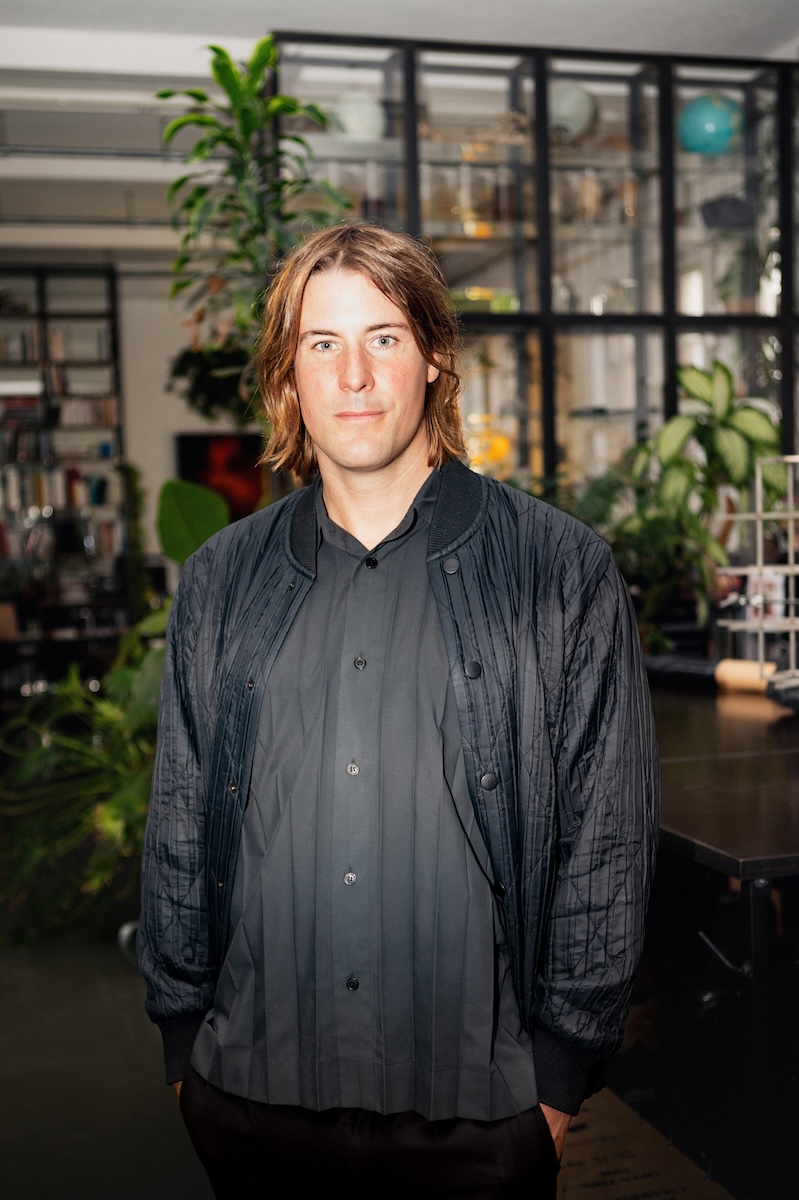 Julian Charrière,
Copyright the artist; photo by Nora Heinisch.
Julian Charrière,
Copyright the artist; photo by Nora Heinisch.
WHITEWALL: You have had an incredibly busy year, with exhibitions at Sean Kelly Gallery, the Museum Frieder Burda, and a significant installation in Basel for Globus Public Art Project’s second iteration. How was it preparing for all these major moments?
JULIAN CHARRIÈRE: It has been quite a whirlwind of a year, with Controlled Burn being on view with Sean Kelly both on the East and West Coast in the U.S., as well as in Mexico at LagoAlgo. I found that it found new meaning presented there, juxtaposing our anthropogenic combustion and industrial fires with the immense heat of the inner Earth, still stirring in the local Popocatépetl volcano.
As for preparation, it is always a balancing act. A central tenet of my practice is to renegotiate our relationship to the world around us, to unpick the deadlocks we find ourselves in with our antiquated definitions of nature and landscape. It is a renegotiation that cannot only be mental, rather that in order to think differently we need to experience differently, something which in the past has led me on journeys to otherwise quite inaccessible areas, whether this is the Bikini Atoll or the polar regions, or most recently the Clarion-Clipperton Zone. The latter was for a film project, probing underwater for aesthetic languages with which we can address urgent issues that often lack visuals, like, for instance, deep-sea mining. In order to prepare, I often collaborate with local experts and scientists, to make sure the projects are as principled as possible.
For instance, with my new initiative “Calls for Action,” the aim was to bring a vision of a Western Andean cloud forest in Ecuador to Basel—one of Earth’s 36 key biodiversity hotspots. Going to this pristine and sensitive ecosystem, our preparation was quite intense, in order to ensure we would not be disruptive to the flora, fauna, or people there. To do so, we worked extremely closely with our conservation partners Art into Acres, Re:wild, and on-the-ground local Ecuadorian organization Foundation Jocotoco. It shows how often, if not always, preparation is best served through cooperation.
“A central tenet of my practice is to renegotiate our relationship to the world around us,”
Julian Charrière
 Julian Charrière, Installation view, “Buried Sunshine,” Sean Kelly, Los Angeles, USA, 2023; Copyright the artist; VG Bild-Kunst, Bonn, Germany, Photo by Brica Wilcox, Courtesy: Sean Kelly.
Julian Charrière, Installation view, “Buried Sunshine,” Sean Kelly, Los Angeles, USA, 2023; Copyright the artist; VG Bild-Kunst, Bonn, Germany, Photo by Brica Wilcox, Courtesy: Sean Kelly.
“Buried Sunshine” at Sean Kelly Captures a Fated Relationship
WW: You kicked off the year with an exhibition in New York, “Buried Sunshine,” at Sean Kelly, comprising photography, sculptures, and film. What was the impetus for this show?
JC: At the time, I had recently completed my film Controlled Burn, which was this cosmic journey through deep time, catapulting through the smoke of humankind back to long-gone biomes, the primordial forests that today constitute our fossil fuels. The film is shot with an aerial drone, whose disorientating voyage barrels between an abandoned open pit coal mine, a decommissioned oil rig, and the rusting cooling tower of a power plant. Amidst imploding fireworks, you catch almost subliminal glimpses of ancient fern species and moths, spirit guides that evolved during the carboniferous geological period, long before anything remotely hominid saw the light of day. It alludes to a history far beyond the scope of our own imagination, and in a way this was also the drive for the show, to consider our story with burning oil and coal and natural gas.
In terms of modernism, our control of fossil fuels has been a story of success, but now perhaps one could frame it more like a doomed love story, even an abusive relationship. It has been both enlightening and transformative, comforting and threatening, obsessive and destructive. Our relationship to these energies is on one hand painfully intimate, omnipresent in our everyday life, but it is also cosmic, relying on the nuclear fusion of the sun and plants as organisms which can fossilize these solar rays in the strata across eons. By linking celebratory pyrotechnics with derelict extraction architecture, as well as other “hot” and unstable materialities, like volcanic glass and bituminous tar, I hoped to capture some sense of that long and winding fated and faithful relationship.
WW: The new series from this exhibition, Buried Sunshines Burn, is a particularly immersive body of work with a sinister message. Can you tell us how this new body of work began?
JC: In many ways, “Buried Sunshines Burn” and Los Angeles have the same material origins, which is to say hydrocarbons. As a city, it is a spatial anomaly, a sprawl built not only with the financial accelerant of oil but also built directly on top of the fields themselves. Even now, there are five thousand active wells in the city, hidden behind plywood and in fake buildings. In the past there were tens of thousands more. The artworks themselves are so-called heliographies, in fact one of the medium’s oldest techniques, first developed by French inventor Nicéphore Niépce in 1822.
To realize them, a light-sensitive emulsion made with tar is used to create the photographic imprints of local oil fields, which I shot from a little rackety helicopter, onto highly polished stainless steel plates. The tar we collected from naturally occurring tar seeps, like the famous La Brea site, but also the local McKittrick, and Carpinteria Tar Pits. It shows some of the state’s largest reserves, including the immense Kern River Oil Field in the San Joaquin Valley, the Placerita and Aliso Canyon Oil Fields in Santa Clarita, and the giant Inglewood Oil Field situated in the heart of L.A. It foregrounds the material reality and excess of extraction which underpins our industrial progress.
As an artist being interested in visual communication, it also felt deeply poignant that fossil fuels have played such an intrinsic role in Hollywood, arguably the image-making mecca in the world. It was also a way to reconcile photography with its material and geological origins, because often we think of pictures as immaterial, especially digital photography. But behind every flash there is energy expenditure, which inevitably relies on natural resources to be extracted.
 Julian Charrière, “Calls for Action,” 2024, installation view of “I Feel the Earth Whisper,” Museum Frieder Burda, Baden-Baden, Germany, 2024, photo by Nikolay Kazakov, copyright the artist; VG Bild-Kunst, Bonn, Germany.
Julian Charrière, “Calls for Action,” 2024, installation view of “I Feel the Earth Whisper,” Museum Frieder Burda, Baden-Baden, Germany, 2024, photo by Nikolay Kazakov, copyright the artist; VG Bild-Kunst, Bonn, Germany.
Intense Research Transforms Into Artistic Methodologies
WW: I imagine there is an intense period of research before any sort of translation into physical or visual forms. Is there a moment when you stop researching and start making?
JC: I would not say that there is a clear line where the research ends, and then making begins, per se, but perhaps rather that at some point the research expands to a point where it begins to encompass also the real world beyond it. It transforms into an artistic methodology, which I have in the past described as fieldwork, but more accurately should be described as pursuing an encounter—seeking to commune with the material history that underpins our mythologies and sciences. Sometimes that only remains in trace amounts, like the radioactivity hidden under the sand of nuclear test sites, softly crackling beyond any human sense, but it is proof of the past.
I find it particularly interesting to uncover those pasts which we have willfully or carelessly cast by the wayside, often because they did not complement the now very well, or serve the future we imagined for ourselves. It is hubristic of us to think this way, of course—that the past, the present, and the future are somehow distinct spaces, upon which a door can be conveniently closed. What you try to bury always resurfaces, and I believe art is a particularly good tool for making inquiries into this, as it is more adept to deal with the abstract, diffused, and complex.
“What you try to bury always resurfaces, and I believe art is a particularly good tool for making inquiries into this,”
Julian Charrière
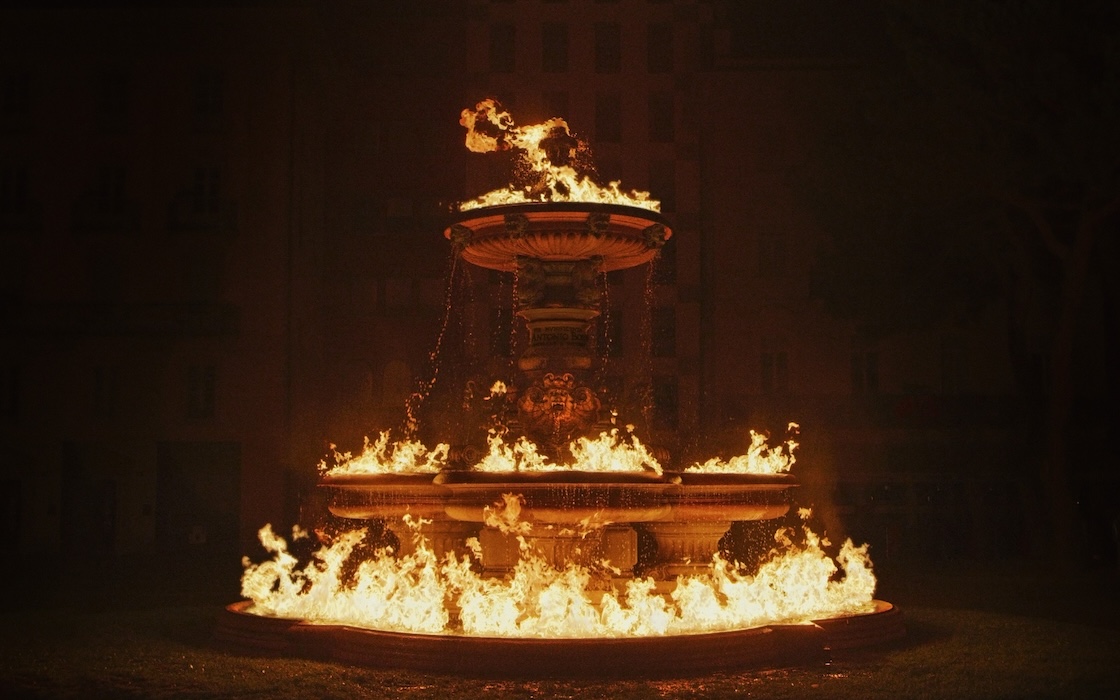 Julian Charrière, “And Beneath It All Flows Liquid Fire,” 2019, video still, copyright the artist; VG Bild-Kunst, Bonn, Germany.
Julian Charrière, “And Beneath It All Flows Liquid Fire,” 2019, video still, copyright the artist; VG Bild-Kunst, Bonn, Germany.
“Calls for Action” Opens a Window Between Two Ecosystems
WW: Your initiative “Calls for Action” is currently on view in Basel and in Baden-Baden. Could you tell us how this project started?
JC: “Calls for Action” began with Fondation Beyeler and the Globus Public Art Project, which is a program that champions art in public space in the heart of the city of Basel. The site is undeniably in a city, with a lot of pedestrians and billboards and all the conveniences one would expect. This is also perhaps the issue with metropolises, at least in the affluent West, that we have come to expect them to be static. There is a flatness to being protected, where it becomes cognitively possible to remove yourself from the effects of climate change or environmental issues like deforestation or forest fires. How can art address this cognitive dissonance? I wanted to conceive of a project that bridged not only spaces physically, bringing a primordial forest into Basel, but I also wanted those who engage with the project to connect emotionally, across such vast distances. This was the idea of “Calls for Action.” To open a window between two remote ecosystems and remind participants that these seemingly disparate locations exist in the same planetary network.
The artwork consists of a screen, with a 24-hour live-stream from the cloud forest, and an accompanying phone booth, where you can not only listen to the woodland, but project your voice into it. So it is quite a playful setup but with a serious message, showing how our actions as well as inactions have consequences. A reminder that even though few people have visited this remote woodland, there is a good chance you have bought products from a Western company that sources wood there, sometimes legally but also often illegally.
It was also important that the project was not solely philosophical in nature, but that it would have practical environmental outcomes, too, which is why I reached out to my friend Dr. Haley Mellin and her NGO Art into Acres. I had worked with her previously, on supporting the protection of 11,307 hectares of primordial cloud forest in Peru as part of my exhibition “Controlled Burn” at the Langen Foundation. So we decided to work together again on “Calls for Action,” in order to support the protection of the areas that you see in the live-stream.
With the support of Museum Frieder Burda, we were also able to set up a second stream in a coastal forest in Ecuador, which is currently on view in their 20th anniversary exhibition “I Feel the Earth Whisper,” where I am presenting work alongside the great Bianca Bondi, Ernesto Neto, and Sam Falls. I imagine these first iterations as the beginning of a much longer project, reaching into a vast array of primordial forests, as well as oceanic habitats, casting a light on the connectivity which defines the resilience of our planet.
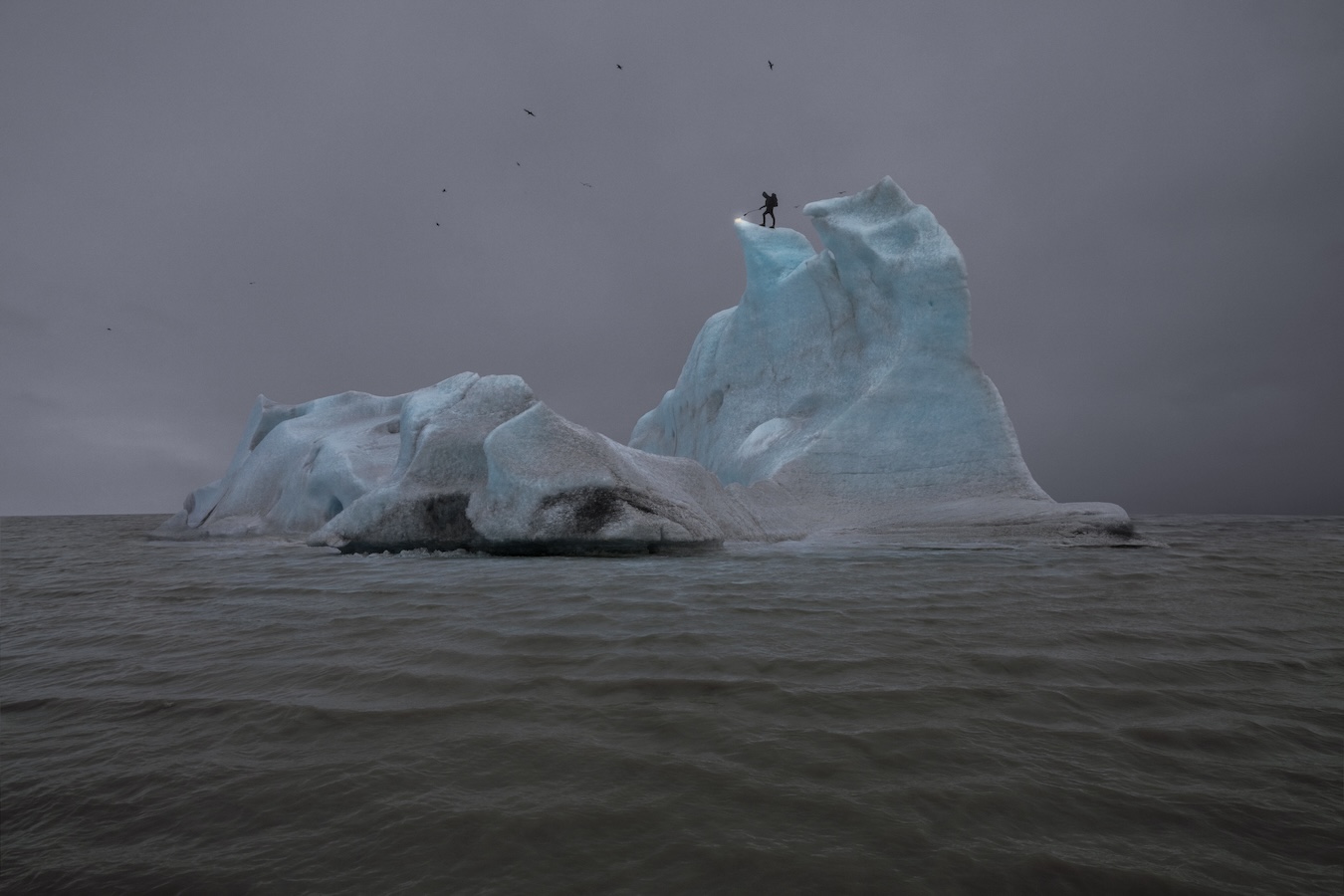 Julian Charrière, “The Blue Fossil Entropic Stories (detail),” 2013, copyright the artist: VG Bild-Kunst, Bonn,
Germany.
Julian Charrière, “The Blue Fossil Entropic Stories (detail),” 2013, copyright the artist: VG Bild-Kunst, Bonn,
Germany.
Donate, Support, and Constantly Question
WW: “Calls for Action” presents a collaboration between the conservation of critically endangered areas and contemporary art, which takes actionable steps that help regions of this nature in measurable ways. What advice would you have for others looking to get involved or support?
JC: For “Calls for Action,” I would warmly recommend visiting the website http://CallsforAction.Net/ to learn more about the project. There you will find a section where individuals can make a donation to Art into Acres, and directly support the protection of the landscapes on view in the project. But there are private actions, too, beyond this, of course, which rely on our curiosity and willingness to engage, to constantly question how we live our lives, who we support and collaborate with, what causes we champion, what sacrifices we can make, what messages we proliferate, and what acts in our daily life can be better adapted to support ecological stability and minimize our potential for destruction and disturbance. This is the spirit both of my practice and of my studio—to always question our actions and ensure we operate as thoughtfully as possible.
“This is the spirit both of my practice and of my studio—to always question our actions and ensure we operate as thoughtfully as possible,”
Julian Charrière
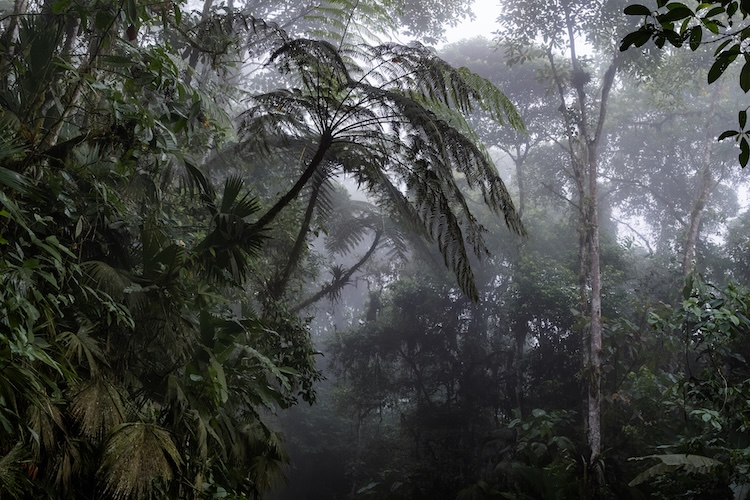 Julian Charrière, “Calls for Action,” 2024, behind the scenes in Western Andean Cloud Forest, Ecuador, copyright the artist; VG Bild-Kunst, Bonn, Germany
Julian Charrière, “Calls for Action,” 2024, behind the scenes in Western Andean Cloud Forest, Ecuador, copyright the artist; VG Bild-Kunst, Bonn, Germany
The Artist Reminds Us that Everything is Entangled
WW: Your practice has taken you all over the world and has allowed you to spend time in some of the most remote areas on the planet. Is it a challenge to adjust to these climates? Or is it harder to come back home?
JC: What is “remote” is always a question of perspective. For me, when you arrive in what for us appears perhaps like the end of the world, what strikes me is the liveliness that greets you. What seems to us as remote is in fact a habitat and home to many others, human and nonhuman alike. It is all a matter of perspective. Much in the same way that a shipwreck becomes a reef, the zones from which we exclude ourselves from can become paradises for all manner of organisms. It is a reminder that there is no here or there, with only “over there” affected by global warming or ecological damage. Everything is entangled.
WW: What are you most looking forward to for the remainder of 2024?
JC: In October, I am opening my solo exhibition “Stone Speakers” at Palais de Tokyo, wherein a parliament of volcanoes will converge in the museum. Visitors will be brought on a dreamlike katabasis down into the barrels of the Earth, carried by the sounds of active volcanoes in heated conversations. From these geological mouthpieces to something more organic, I also have an upcoming solo show titled “Solarstalgia” at Arken in Denmark this November, which will be deeply immersive, dripping with meltwater and petrochemicals.








